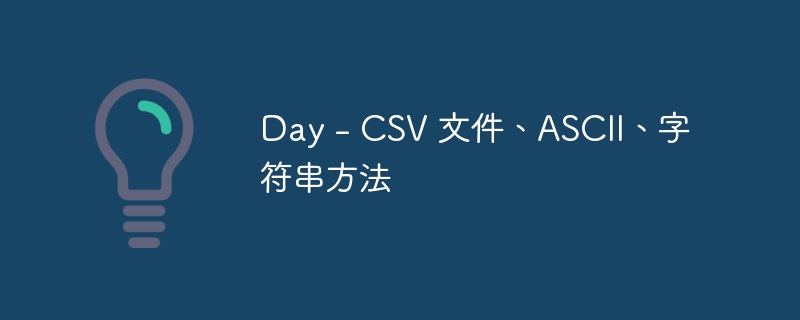◎欢迎参与讨论,请在这里发表您的看法、交流您的观点。
Day - CSV 文件、ASCII、字符串方法
ID:21912 / 打印
csv(逗号分隔值):
csv 文件代表一行,行内的每个值都用逗号分隔。
csv 文件看起来像 excel,但 excel 文件只能在 excel 软件中打开。
csv 文件用于所有操作系统。
我们可以打开以下两种格式的csv文件。
f =open("sample.txt", "r") with open("sample.txt",’r’) as f: r-读
打开文件进行读取。文件必须存在。
w-写
打开文件进行写入。创建一个新文件或覆盖现有文件。
rb-读取二进制
这用于读取二进制文件,如图像、视频、音频文件、pdf 或任何非文本文件。
store.csv
player,score virat,80 rohit,90 dhoni,100
import csv f =open("score.csv", "r") csv_reader = csv.reader(f) for row in csv_reader: print(row) f.close() ['player', 'score'] ['virat', '80'] ['rohit', '90'] ['dhoni', '100']
ascii:
ascii 代表美国信息交换标准代码。
ascii 表:
48-57 - 数字(数字 0 到 9)
65-90 - a-z(大写字母)
97-122 - a-z(小写字母)
使用 ascii 表的模式程序:
for row in range(5): for col in range(row+1): print(chr(col+65), end=' ') print()
a a b a b c a b c d a b c d e
for row in range(5): for col in range(5-row): print(chr(row+65), end=' ') print()
a a a a a b b b b c c c d d e
使用 for 循环:
name = 'pritha' for letter in name: print(letter,end=' ')
p r i t h a
使用 while 循环:
name = 'pritha' i=0 while i<len(name): print(name[i],end=' ') i+=1
p r i t h a
字符串方法:
1.大写()
python中的capitalize()方法用于将字符串的第一个字符转换为大写,并将所有其他字符转换为小写。
txt = "hello, and welcome to my world." x = txt.capitalize() print (x)
hello, and welcome to my world.
使用 ascii 表编写大小写程序:
txt = "hello, and welcome to my world." first = txt[0] first = ord(first)-32 first = chr(first) print(f'{first}{txt[1:]}') hello, and welcome to my world.
2.casefold()
python 中的 casefold() 方法用于将字符串转换为小写。
txt = "hello, and welcome to my world!" x = txt.casefold() print(x)
hello, and welcome to my world!
使用 ascii 表编写一个折页程序:
txt = "hello, and welcome to my world!" for letter in txt: if letter>='a' and letter<'z': letter = ord(letter)+32 letter = chr(letter) print(letter,end='')
hello, and welcome to my world!
3.count()
python 中的 count() 方法用于统计字符串中子字符串的出现次数。
txt = "i love apples, apple is my favorite fruit" x = txt.count("apple") print(x) 2
为给定的键编写一个计数程序:
txt = "i love apples, apple is my favorite fruit" key="apple" l=len(key) count=0 start=0 end=l while end<len(txt): if txt[start:end]==key: count+=1 start+=1 end+=1 else: print(count)
2
编写一个程序来查找给定键的第一次出现:
txt = "i love apples, apple is my favorite fruit" key="apple" l=len(key) start=0 end=l while end<len(txt): if txt[start:end]==key: print(start) break start+=1 end+=1
7
编写一个程序来最后一次出现给定的键:
txt = "i love apples, apple is my favorite fruit" key="apple" l=len(key) start=0 end=l final=0 while end<len(txt): if txt[start:end]==key: final=start start+=1 end+=1 else: print(final)
15
任务:
for row in range(4): for col in range(7-(row*2)): print((col+1),end=" ") print()
1 2 3 4 5 6 7 1 2 3 4 5 1 2 3 1
for row in range(5): for col in range(5-row): print((row+1)+(col*2),end=" ") print()
1 3 5 7 9 2 4 6 8 3 5 7 4 6 5
